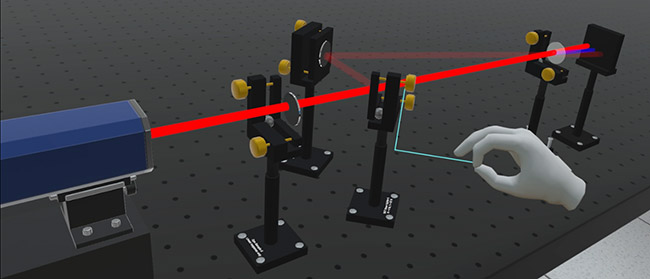
Virtual Laser Lab Simplifies Training, Increases Safety
WÜRZBURG, Germany, Sept. 28, 2021 — Scientists at the Julius-Maximilians-University (JMU) of Würzburg have developed a novel virtual-reality (VR) laser laboratory called femtoPro that enables students to familiarize themselves with optical experiments and related protocols.
In femtoPro, users wear VR goggles and manipulate optical elements on a VR laser table. In this way, the coarse and fine positioning of mirrors, lenses, iris apertures, and/or other devices can be changed intuitively and with the same attention to detail as in the real laboratory. The properties and effects of these elements on the laser beam are calculated and displayed in real time according to physical laws.
“Flight simulators have become indispensable for the realistic practical training of pilots. We have now applied this concept to short pulse lasers for the first time worldwide,” explained Tobias Brixner, a developer of femtoPro and chair of the physical chemistry department at JMU.

Scientists at the Julius-Maximilians-University (JMU) of Würzburg developed the novel (VR) laser laboratory “femtoPro”. In femtoPro, users wear VR goggles and manipulate optical elements on a VR laser table. Courtesy of JMU.
A challenge in building the VR simulation is that laser beams are not simply “line-shaped,” but have a Gaussian cross-section, the diameter of which can grow larger and smaller with propagation.
Additionally, the interaction with matter is highly complex and includes widely known phenomena such as refraction of light on a glass, as well as nonlinear optics leading to frequency conversion, as happens in color change. As a result, accurate simulation is usually very time-consuming.
“To realize an interactive learning lab for such optical systems in VR, we had to accelerate the necessary calculations so that they run in real time on a commercially available consumer VR platform,” said Sebastian von Mammen, head of the games engineering group in the computer science department and chair for human-computer interaction at JMU.
The acquisition costs of the virtual lab were only a few hundred euros (€100 equals $117.08). A real short-pulse laser lab would require an investment of hundreds of thousands of euros.
Published: September 2021